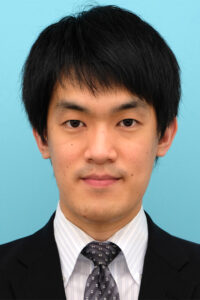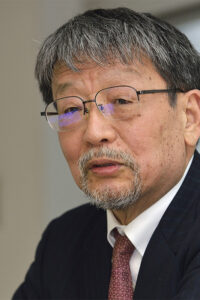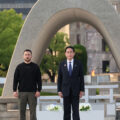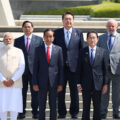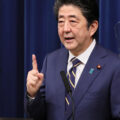Taiwan in International Politics: How to View US-Japan-China-Taiwan Relations

“Addressing Taiwan’s geopolitical issues requires thinking not only about where Taiwan is, but also what Taiwan is.”
Map: Peter Hermes Furian / PIXTA
Liu Yenfu (Reporter, Analysis Department, Toyo Keizai Inc.) vs Wakabayashi Masahiro (Professor Emeritus, Waseda University)
From two time axes
Liu Yenfu: For the past few years, there has been a lot of discussion about a Taiwan emergency. While discussions on deterrence against China are progressing in Japan, there is also the view that the situation is not so dire and that “emergency is a fiction.” From the standpoint of having studied Taiwan for a long time, how does Professor Wakabayashi view the current situation?
Wakabayashi Masahiro: I would like to look back on how Taiwan appeared in international political history and how it has been treated from two different timelines. First, there is a long timeline starting from the 17th century. Within this long timeline, there were four times when Taiwan became the focus of war-related events.
The first was in the 17th century. At that time, the Ming dynasty’s Haijin (sea ban) policy [forbidden civilian maritime trade] meant that all forces wishing to trade in East Asia had no choice but to become pirates. European countries, Wakou [Japanese pirates of the time], and the Qing dynasty [founded in Manchuria in 1616] in northern China were no exception. Amid such tensions, the southern part of Taiwan was occupied by the Dutch, who were expelled by the forces of Zheng Chenggong (Koxinga) (1624–62). Furthermore, the Kingdom of Tungning founded by Zheng Chenggong (Taiwan, 1661–83) was destroyed by the Qing dynasty (1616–1912) in 1683. Through this series of events, Taiwan was recognized as a large island to the east of mainland China, and an island located in the middle of a chain of islands in the Western Pacific. It was also during this period that the geopolitical significance of Taiwan’s geographical location became clear.
The second time was from the 1870s until Japan won the First Sino-Japanese War (1894–95) and took possession of Taiwan. During this period, Japan dispatched troops to Taiwan and French troops attacked northern Taiwan (Sino-French War period, 1884–85). The third period was from the late 1930s to the mid-20th century, from the Second Sino-Japanese War (1937–45) to the subsequent Chinese Civil War (1927–49) and the two Taiwan Strait Crises in the 1950s. However, Taiwan was not the primary target in these wars. Rather, Taiwan was the collateral damage from the increased geopolitical significance of these wars.
In contrast, the recent “Taiwan emergency,” as the term suggests, recognizes that Taiwan is at the center of tensions. Therein lies the greatest significance from the perspective of Taiwan’s history.
Let’s look at the situation from another timeline. It is the postwar history of 73 years starting in 1950 (the period from 1945 to 1950 was a transitional period).
There was a US defense line called the Acheson Line (1950), a term that is now only remembered by professional international political scientists. After the Chiang Kai-shek administration (1948–75) fled to Taiwan at the end of 1949, the Truman administration (1945–53) of the United States announced the Taiwan Strait non-intervention policy in January 1950 (Declaration of Non-Intervention in Taiwan). Immediately thereafter, US Secretary of State Dean Acheson declared Asia’s defense line against the Soviet Union. The Acheson Line extends from the Aleutian Islands, through the Japanese archipelago, through Okinawa, and toward the Philippines. However, Taiwan is not included in this defense line. The same goes for South Korea.
Liu: In Japanese, it is translated as fukotai boeisen (non-retreating line of defense).
Wakabayashi: However, this defense line did not materialize as planned. The Korean War (1950–53) broke out, and an armistice was finally concluded at the 38th parallel due to US intervention [the Acheson Line moved westward]. Afterwards, the US Seventh Fleet was dispatched to the Taiwan Strait, and the defense line moved from the east side of Taiwan to the Taiwan Strait [the west side of Taiwan]. The Acheson Line took a major “progress” with the United States’ intervention in Vietnam [1965]. However, in Vietnam, the lines were subsequently redrawn.
Nevertheless, all of Japan, including Okinawa, South Korea, and Taiwan still remain within the solid structure of the “advanced” Acheson Line, as if it were natural for East Asia to continue to fit within it. However, in reality, that structure is shaking, and as a result, the security environment in East Asia is forced to change.
In the early 1970s, the United States and China became closer, which led to the normalization of diplomatic relations between Japan and China and the severance of diplomatic relations with Taiwan (1972). Furthermore, in 1979, the United States established diplomatic relations with China and severed diplomatic relations with Taiwan. This is common knowledge in Taiwan studies, but at the same time as the United States severed diplomatic relations, Congress enacted the Taiwan Relations Act (TRA). In other words, they made arrangements to sell arms to “Taiwanese people.” In 1981, the United States further entered into an agreement with China on the issue of arms sales, the US–People’s Republic of China (PRC) Joint Communiqué (August 17 Communiqué). The Reagan administration (1981–89) rejected China’s request to set a deadline to end arms sales to Taiwan. The United States’ stance of positioning Taiwan within its sphere of influence and securing its strategic interests in East Asia has not changed since then. This is why the feud with China is occurring.
Liu: Taiwan’s geographical location has always been a point of contention throughout its long history, and as such is an unavoidable geopolitical issue. If the structural turmoil that has occurred over the past 70 years is the cause of the current Taiwan emergency, we must thoroughly understand the international environment in which Taiwan is currently placed.
Wakabayashi: That’s it. Seventy years is a long time because it is almost the same as my life. It is not surprising that there have been major changes in that time.
What is “One-China” policy?
Liu: I feel that the fact that such changes in Taiwan are not well understood in Japan may be leading to major problems. Have you ever felt that way?
Wakabayashi: When I started my research, the mainstream research trend was Marxism, and Chinese research followed the same trend. Under the ‘Marxian economic view of Chinese socialism’ and the ‘ideological view of US imperialism,’ the existence of Taiwan was inevitably neglected. I once heard from Dai Guo-hui (1931–2001), an agricultural economist who studied at the University of Tokyo and conducted research at the Institute of Developing Economies (IDE) in the 1950s, about the frustrations he experienced as a Taiwanese.
Liu: Japanese leftists often criticize Taiwanese for their ties to the Japanese right. It is true that there is such an aspect. However, from a historical perspective, it is also a reaction to the neglect of Taiwan, as Professor Wakabayashi said. In the 1920s and 1930s, Taiwan’s anti-colonial political and social movements had an affinity for leftist ideas. Afterwards, many Taiwanese independence activists resisted the oppression of human rights and political persecution by the Republic of China (ROC) government and fled to Japan. They also looked forward to building a relationship with the [Japanese] leftists from the perspective of decolonization regarding the new “colony” known as the ROC.
However, they [Taiwanese independence activists] were ignored by [Japan’s] pro-China leftists. In searching for Taiwan’s identity, Taiwan sought to differentiate itself from China by drawing on its experience when it was ruled by Japan, its former colonial power. For this reason, there was an aspect in which they were strategically forced to form solidarity with the [Japanese] right wing.
Wakabayashi: I have always wanted Taiwan studies to be recognized as an academic field in Japan’s intellectual society. I have also experienced difficulties in disseminating knowledge. However, on the other hand, I feel that many of the newspaper reporters who have been assigned to the Taiwan bureau at some point are eagerly reading my books.
Liu: What I really feel is that the quality of Japanese reporting on Taiwan is extremely high. Reporters assigned to Taiwan study hard and carefully cover the area. In this way, I am updating my awareness and knowledge of Taiwan. On the other hand, the speeches of so-called experts are not necessarily linked to the news reports. Regarding coverage of Taiwan, some have criticized the Asahi and the Mainichi shimbun newspapers as leaning to the right and not recognizing ‘One-China.’ I think this view is due to not necessarily being able to directly see the changes in Taiwan.
Wakabayashi: In the Japan–China Joint Communiqué (1972), the Government of Japan “fully understands and respects this stand of the Government of the People’s Republic of China.” But it doesn’t say “recognizes.” This is the same stance as the United States regarding the so-called “One-China” policy. Since it is a policy, it will be adjusted according to the situation.
My understanding is that the US and China reached a compromise in the 1970s. The idea is that the US will allow the PRC to represent China in international society, but will not allow Taiwan’s ROC to represent China. Japan also shares this recognition. That is why the PRC, not Taiwan, is included in international organizations such as the United Nations. So what should Taiwan do? There is a peaceful settlement principle here. The US’s stance is to say that China-Taiwan relations should be resolved peacefully, but not say anything about the outcome of the resolution. On top of that, the TRA mentioned earlier exists.
The PRC naturally considers itself to be China’s representative [in international society], and at the same time considers Taiwan to be its own. However, at that time, it was more advantageous to align with the United States’ peaceful settlement principle, so the PRC advocated “the ‘peaceful’ reunification of the homeland.” However, since this is an internal matter, he added to the confirmation with the United States that he would not at all announce that he would abandon an armed solution. This is often emphasized by Xi Jinping.
Why was a compromise reached between the two sides? Economic cooperation from the West was essential for China. That was the basic condition of the reform and opening-up [in 1978]. The US had liberal expectations. Even under the Communist Party one-party rule, there are expectations that if the economy opens up to the outside world, the system will change to be more friendly to the West.
However, a recent change is that this expectation in the US has disappeared. This has changed since the second Obama administration, and it has not changed even with Trump and Biden.
Liu: Returning to Japan’s position [in the Japan–China Joint Communiqué], strictly speaking, “(the Government of Japan fully) understands and respects this stand of the Government of the People’s Republic of China, and it firmly maintains its stand under Article 8 of the Potsdam Proclamation.” This is because the Chinese side pointed out that “understands and respects” alone is not enough. It even went so far as to call for the implementation of the Cairo Declaration (1943), which called for the return of Taiwan to the ROC [then Mainland China], or to uphold the position of Article 8 of the Potsdam Proclamation. Since Japan has recognized the PRC as the successor government, it will not deny that Taiwan will be returned to the PRC. However, at present, it does not even recognize that Taiwan is part of the PRC. The language of the Japan–China Joint Communiqué was carefully devised to disapprove of China’s “One-China Principle, which makes Taiwan part of China.”
Wakabayashi: Around 2005 or 2006, academics and businessmen from Japan and China gathered to discuss Japan-China relations and the Taiwan issue, led by Tanino Sakutaro, a former Japanese ambassador to China. Then came Wang Yi, who is said to be the current top diplomat in China, and then Deputy Minister of Foreign Affairs. I heard Tanino and Wang Yi chatting. Wang Yi jokingly told Tanino, “Since it says understands and respects, we’re almost done. Why don’t we just add recognizes?” Of course, Wang Yi and other Japanese and Chinese foreign affairs officials are well aware of the magnitude of the difference between these words.
Is “emergency” a fiction?
Liu: The Chinese side is also dissatisfied with this [US-China] compromise. However, since economic cooperation was also necessary, I accepted the dissatisfaction. As pointed out by Professor Wakabayashi, the reason why the United States and other Western countries provided economic cooperation was primarily to ensure that China would not cause a Taiwan emergency.
The reason why China has stopped invading Taiwan is because it failed in the 1950s and 1960s. The reason it failed was because the United States intervened and supported Taiwan. The United States deterred both China and Taiwan in order to maintain the status quo. Despite China’s dissatisfaction, each actor in the Taiwan Strait agreed to compromise in a situation where economic cooperation was needed. And the product of that compromise is now in turmoil, and this is my understanding of the current situation.
Behind this turmoil are two Chinese thoughts. The first is that there is no longer a need to seek economic cooperation as there was in the past, and the second is that China has established an important position in the world’s supply chains and is now able to discuss the economy on an equal footing. In addition, China is expanding its military power in order to change the current situation with which it is dissatisfied. As a result, China gained a certain level of negotiation ability. Furthermore, China is increasingly dissatisfied with Taiwan’s current state of Taiwanization [emphasizing the importance of Taiwan’s unique culture, society, economy, national character, and independence, rather than viewing it as part of China].
On the other hand, some in Japan have the following views. The United States, which does not want China to lose its hegemony, is provoking China by encouraging Taiwan to strengthen its commitment to the West. That is the cause of the Taiwan emergency. There are further claims as follows. In order to avoid Japan becoming involved in this, Japan should understand the China-Taiwan relationship as an internal matter of China and should not get involved, and should not allow the use of US military bases in Japan.
However, in reality, as mentioned above, both the economic and security deterrence measures against China by the United States and Japan, which wanted to maintain the status quo, were effective. Therefore, a compromise was reached in East Asia. However, as China has become relatively stronger, the conditions that made the compromise possible are beginning to break down. Without directly facing this change in preconditions, she has no choice but to say that the “emergency is a fiction” and that the argument that the United States is trying to cause an emergency is wild.
If a Taiwan Strait emergency really were to occur, the world’s leading supply chains in East Asia would collapse, and Japanese society would be unable to maintain its current way of life. If Japan does not allow the US military to use its bases [in the event of a Taiwan emergency], the Japan-US alliance may collapse. There is also the question of whether Japan, which has a large budget deficit, can increase its defense burden [in order to maintain a defense force that can replace the US military]. In order to prevent a Taiwan emergency from occurring, it is necessary to develop a [deterrence policy against China] in accordance with the situation in Taiwan, rather than the compromises of the past.
I often hear the opinion that it is important to have dialogue with China. This is true. The problem is that when we examine past diplomatic achievements, there were various preconditions for dialogue and its outcomes. What are the conditions for dialogue to be possible and for results to be produced? It is by no means just a military deterrent. There is also the issue of economic national power, as well as technology and the flow of people. It is necessary to have a perspective that clearly defines the strategy, what the goals are, and how the dialogue should be conducted.
Wakabayashi: As I mentioned earlier, for the past 73 years, we have lived in a world where the Acheson Line has moved forward. There is a balance of power between inside and outside the line. From Taiwan’s perspective, peace has been achieved through this balance. We are being asked to provide a prescription for this major structural change. Structural change is by no means a “fiction.”
Taiwan’s change and identity
Wakabayashi: I would like to ask Mr. Liu, the Japanese press often reports that “Taiwanese public opinion is not in favor of unification or independence, but rather maintains the status quo.” How do you see this?
Liu: For example, in an attitude survey conducted by Taiwan’s National Chengchi University for many years, many people answered that they basically want to maintain the status quo. However, what is the “current situation” of maintaining this status quo? This means that Taiwan wants to maintain its “state” of being a de facto independent state. To be honest, most Taiwanese people want to be independent. This “current situation” has a faint tinge of Taiwan’s independent status. That’s the status quo. If we shorten this and express it as “maintaining the status quo, neither unification nor independence,” this nuance will not be visible. I feel that there is a problem in that sense. However, I think it is difficult to express this nuance in a short way.
Wakabayashi: Another issue is that of Taiwan’s identity. Respondents to the National Chengchi University survey may have been wary of losing US support or being invaded by China when giving “Taiwan independence” as their answer. These considerations may be said to be constraints on the “independence” response. The question about “identity” on the other hand does not carry such constraints. Therefore, the number of respondents who answered that they are “Taiwanese” is larger than the number who chose “Taiwan independence.”
I refer to the changes that have occurred in Taiwan over the past 70 years as “Taiwanization of the ROC.” Along with democratization, the search for Taiwan’s identity progressed in four areas: the regime elite, the legitimacy of political power, the ideology of national unity, and the state system. The Japanese government and major media will no longer refer to it as “ROC” after the normalization of diplomatic relations between Japan and PRC, so they will refer to it as “Taiwan.” In that case, “Taiwanization of the ROC” becomes “Taiwanization of Taiwan,” which is nonsense, but in fact, in Taiwan, this is not nonsense and has proceeded with democratization as a structural change.
Liu: An appropriate expression might be, “Public opinion is neither unified nor independent, but maintains the status quo. However, Taiwanese identity is the overwhelming majority.”
Wakabayashi: This should be seen as a result of ROC’s Taiwanization. If we look at the sociological substance of the nation, what we now find in Taiwan is not another China in opposition to the PRC. This is the emergence of a de facto nation-state with the size of Taiwan. Under international law, of course, it does not have an internationally recognized name as a nation. In other words, they are unable to become “independent.”
Liu: Simply put, Taiwan is an unrecognized state. Moreover, it is unique in that it is an unrecognized state that was once a permanent member of the United Nations Security Council. It already exists in international society as a de facto sovereign entity. Why does Taiwan exist as an unrecognized state? What kind of history has it had as an unrecognized state? What are you trying to gain and what are you trying to protect? If we do not try to understand this point, we will not be able to understand the perspective of “What is Taiwan?” as Professor Wakabayashi always points out.
Conversely, it is extremely dangerous to talk about security policy or policy towards China and Taiwan without understanding this.
Wakabayashi: Addressing Taiwan’s geopolitical issues requires thinking not only about where Taiwan is, but also what Taiwan is.
Liu: From China’s point of view, ROC’s Taiwanization is de-Sinicization Some people view this de-Sinicization as changing the status quo, and that this in itself is a problem. However, should we really criticize Taiwan’s changes in pursuit of freedom, democracy, and a community of its own? This feeling is at the heart of Taiwanization.
Wakabayashi: Following Japan’s colonial rule, a movement for suffrage and political freedom arose during the ROC’s postwar martial law regime (1947–87). As a result, democracy was finally achieved. These were events that occurred within the structure of the ROC, which once claimed to be “authentic China.” Therefore, it is connected to the rise of Taiwanese identity. Taiwan’s modern history has been based on this logic. Still, I believe that the starting point was resistance to human rights oppression.
Liu: Taiwan’s democracy has now become a weapon. For example, same-sex marriage has been legalized, digital democracy is advancing, and social movements are flourishing.
Wakabayashi: Naturally, Taiwan also has a conservative class, and there are many voices that deny major changes in society. Still, I feel that Taiwanese people want to gain sympathy from the world by showing that they are realizing the universal values of democracy, liberalism, and human rights.
Liu: People in Taiwanese society do not necessarily have a particularly high level of awareness. However, social movements are seen more positively than in Japan, and Japan is a society where people can speak freely and actively lobby legislative bodies. The economy has also become a major factor recently. Semiconductors, in particular, are seen as being able to be used as diplomatic cards.
Wakabayashi: Taiwan is an advanced society in many ways. People of my generation may not have a strong sense that Taiwan is an advanced society, but young people’s perceptions are different. I believe that Taiwan’s society, which is superior to Japan’s, is becoming quite well known among young people, most recently for example through its response to the coronavirus outbreak.
Moderated by Nakayama Hideki of Sekai
Translated from “Kokusai Seiji no nakano Taiwan: Nichibeichutai kanekei wo do miruka (Taiwan in International Politics: How to View US-Japan-China-Taiwan Relations),” Sekai, September 2023, pp. 40-47. (Courtesy of Iwanami Shoten, Publishers) [October 2023]
Keywords
- Liu Yenfu
- Toyo Keizai
- Wakabayashi Masahiro
- Waseda University
- Nakayama Hideki
- Sekai
- Taiwan
- China
- diplomatic relations
- Taiwan emergency
- Taiwan Strait
- Acheson Line
- defense line
- non-intervention
- One China
- Taiwan studies
- unification
- independence
- status quo
- identity
- Taiwanization
- unrecognized state
- Japan–China Joint Communiqué
